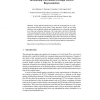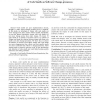TOOLS
2008
IEEE
14 years 5 months ago
2008
IEEE
Abstract. Design patterns provide solutions to recurring design problems in object-oriented programming. Design patterns typically crosscut class boundaries so previous work aimed ...
ICST
2008
IEEE
14 years 6 months ago
2008
IEEE
Evidence suggests that as software ages the original realizations of design patterns remain in place, and participants in design pattern realizations accumulate “grime” – no...
FCCM
2008
IEEE
14 years 6 months ago
2008
IEEE
—Gel is a hardware description language that enables quick scripting of high level designs and can be easily extended to new design patterns. It is expression oriented and extrem...
CSMR
2008
IEEE
14 years 6 months ago
2008
IEEE
We study the impact of design patterns on quality attributes in the context of software maintenance and evolution. We show that, contrary to popular beliefs, design patterns in pr...
ICSR
2009
Springer
14 years 6 months ago
2009
Springer
Abstract. Design pattern formalization is aimed at encouraging the use of design patterns during the design phase. Many approaches focuses on providing solutions with a graphical n...
ICSM
2009
IEEE
14 years 6 months ago
2009
IEEE
This work presents a descriptive and analytic study of classes playing zero, one, or two roles in six different design patterns (and combinations thereof). First, we answer three...
WCRE
2009
IEEE
14 years 6 months ago
2009
IEEE
—Code smells are poor implementation choices, thought to make object-oriented systems hard to maintain. In this study, we investigate if classes with code smells are more change-...
ICAC
2009
IEEE
14 years 6 months ago
2009
IEEE
Dynamic adaptation may be used to prevent software downtime while new requirements and responses to environmental conditions are incorporated into the system. Previously, we studi...
DEXAW
2009
IEEE
14 years 6 months ago
2009
IEEE
— The use of design patterns usually changes the approach of software design and makes software development relatively easy. This paper extends work on a forensic model for Logic...
SAC
2010
ACM
14 years 6 months ago
2010
ACM
Implementing the 23 Gang-of-Four design patterns in the aspectoriented programming language Object Teams/Java (OT/J) yields modularity and reusability results roughly comparable t...



